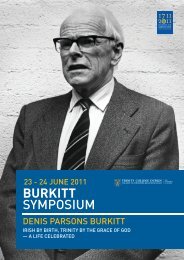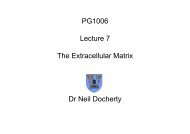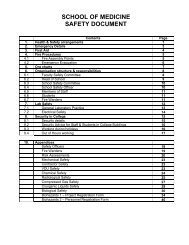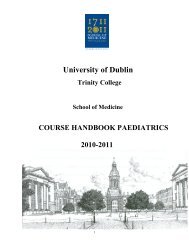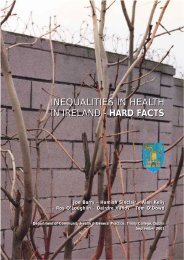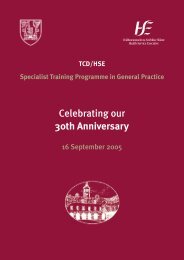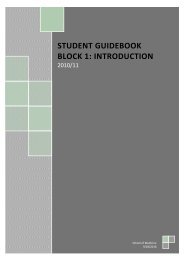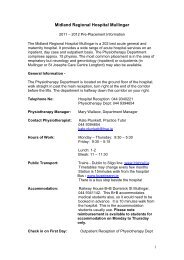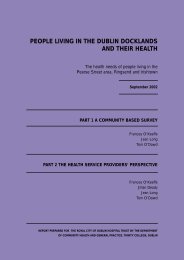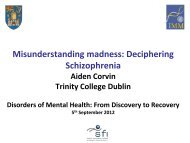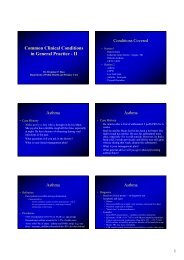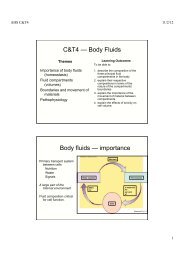year-2-study-guide-2.. - School of Medicine - Trinity College Dublin
year-2-study-guide-2.. - School of Medicine - Trinity College Dublin
year-2-study-guide-2.. - School of Medicine - Trinity College Dublin
You also want an ePaper? Increase the reach of your titles
YUMPU automatically turns print PDFs into web optimized ePapers that Google loves.
Week 9<br />
Thurs. 26 th Nov. 9:00 am Molecular Mechanisms <strong>of</strong><br />
Cancer 5<br />
10:00 am Molecular Mechanisms <strong>of</strong><br />
Cancer 6<br />
Week 10<br />
Thurs. 3 rd Dec. 9:00 am Nano<strong>Medicine</strong> and medical<br />
applications <strong>of</strong> molecular<br />
imaging 1<br />
10:00 am Nano<strong>Medicine</strong> and medical<br />
applications <strong>of</strong> molecular<br />
imaging 2<br />
Dermot Kelleher<br />
Dermot Kelleher<br />
Yuri Volkov<br />
Yuri Volkov<br />
IMM Building: RSL<br />
IMM Building: RSL<br />
IMM Building: RSL<br />
IMM Building: RSL<br />
Methods <strong>of</strong> Teaching and Student Learning<br />
The course is taught for the duration <strong>of</strong> one academic term as a series <strong>of</strong> lectures<br />
dealing with a wide scope <strong>of</strong> topics in Molecular and Translational <strong>Medicine</strong> and is<br />
designed to implement the knowledge accumulated by the students in the closely<br />
related disciplines studied in parallel modules (Anatomy, Clinical Biochemistry and<br />
Molecular Immunology, Microbiology and Pharmacology) for a better understanding<br />
<strong>of</strong> molecular mechanisms <strong>of</strong> human disease and contemporary approaches to their<br />
treatment.<br />
Several lectures <strong>of</strong> the module are focused on the basic molecular mechanisms <strong>of</strong><br />
human development, intracellular communications and signalling as well as<br />
molecular, cell and tissue damage and regeneration. The fundamental knowledge<br />
accumulated from these lectures is subsequently applied for the in-depth<br />
understanding <strong>of</strong> the molecular aspects <strong>of</strong> disease-related impairs in molecular<br />
functions in the context <strong>of</strong> translation <strong>of</strong> this knowledge into clinical practice. The<br />
lectures cover such specific topics as molecular basis <strong>of</strong> inflammation, cancer,<br />
leukaemia and psychiatric disorders, all <strong>of</strong> which refer to clinical patient-related<br />
information. The students are also empowered with the cutting edge technological<br />
approaches to diagnostics and therapy, including Nanomedicine, molecular imaging<br />
and medical proteomics.<br />
Due to a wide scope <strong>of</strong> topics covered by the module, the students are expected to<br />
fully use the taught lecture material and engage in active <strong>study</strong>ing <strong>of</strong> the suggested<br />
reading resources. On specific topics, particularly relevant to the translational<br />
aspects <strong>of</strong> molecular medicine, students should expose themselves to the relevant<br />
original research and clinical publications available through the biomedical databases<br />
and library collections.<br />
Methods <strong>of</strong> Assessment<br />
Summative<br />
The students are assessed via a written examination. The exam consists <strong>of</strong> two<br />
parts. Part A <strong>of</strong>fers an essay type question (which can be chosen from the list) and<br />
constitutes 30% <strong>of</strong> the overall mark. Part B consists <strong>of</strong> short “either/or” type<br />
questions, covering the diverse scope <strong>of</strong> theoretical material <strong>of</strong> the course and<br />
including brief clinical case studies. Each <strong>of</strong> the questions must be attempted and all<br />
<strong>of</strong> them carry equal percentage <strong>of</strong> marks (e.g., value <strong>of</strong> part B is 70% <strong>of</strong> the total<br />
exam mark and comprises 7 short questions. Each <strong>of</strong> these, in this case, carries a<br />
weight <strong>of</strong> 10% <strong>of</strong> the overall mark for the exam).<br />
11



